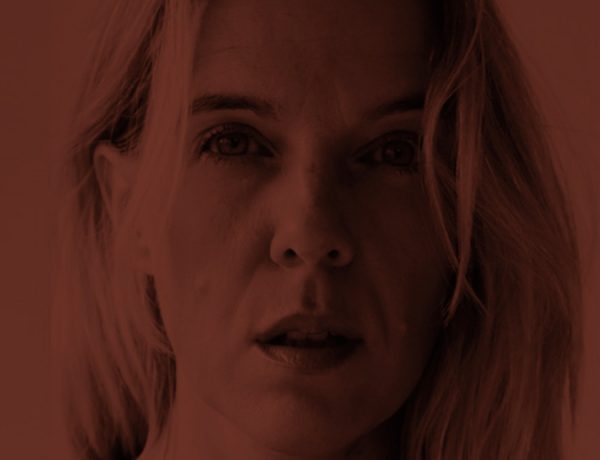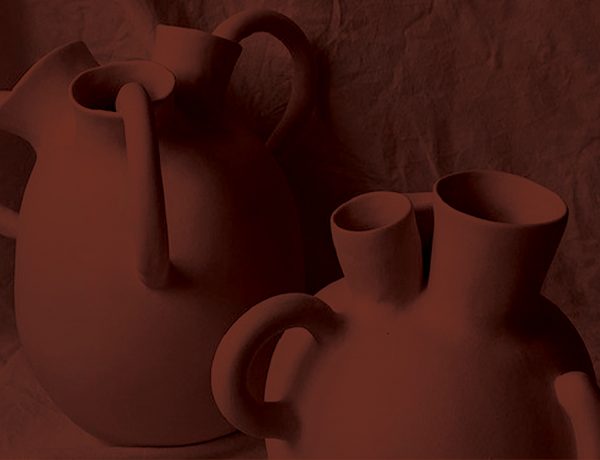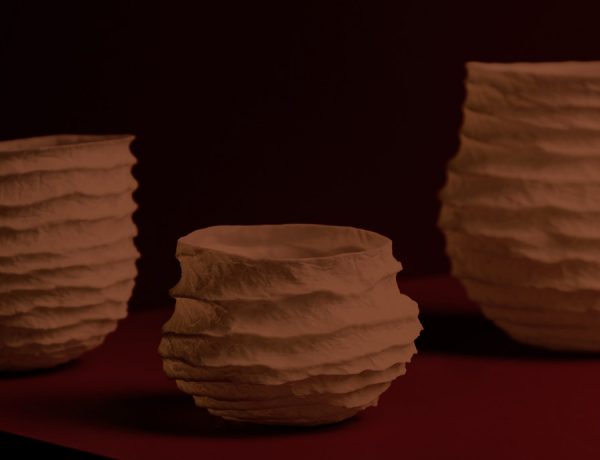Meet Metin Ertürk, a passionate ceramic artist, whose works fascinate you by their flawless smoothness. Read more about his passion for ceramics and Terra Sigillata, his connection to the medium and what drew him into it.
Interview by Bahar Ahu Sağın
You’ve been doing this for many years, without having lost your passion. Each day, you mention waking up with the same enthusiasm to enter the studio with a new idea. This is incredibly fascinating. What kind of passion do you have for ceramics? Would you like to share your secret? How do you spend you day in the studio?
Since ceramics is the only subject I am successful at in life, it is impossible for me to lose my passion. It is the only thing I hold dear in life. The studio is my personal space, my salvaged terrain. Be it stress, anger, excitement, or happiness; I feel everything in there. I am not leaving the world outside, but I care more about ceramics. It goes without saying that I am anti-social. Each day in the studio is different, but also routine. Private lessons, orders, my personal works; I try to fit all in one day. And I am not the kind who works for hours. If I remain in the studio for 10 hours, only 5 hours of it is reserved for working. I am a hyperactive person with a difficulty to focus.
How did you discover ceramics? What is your first recollection?
I was 13-14 years old when I first held mud in my hands. Each year there is a terra cotta symposium in Eskişehir. It is one of the most important art events of the city. I don’t remember exactly which year it was, but it was more like an event not a symposium. I saw it there, and decided to bring some back home. I made a car with its doors opening upwards. I baked it without drying, and of course the result was a disaster. This is my first recollection of ceramics.
How I start to study ceramics is another story. I am dyslexic, and combined with hyperactivity my education background is below average. When I graduated from the middle school, I scored pretty low in the high school entrance exams.Therefore, I had to enroll into a vocational high school. After some research, we decided that ceramics will be suitable education pathway as it will physically exhaust my body. I started ceramics, defined as a lazy boy by our education system. Currently I am pursuing a doctor of arts degree at the Ceramics Department in Mimar Sinan Faculty of Arts.
You made your first solo show in Japan, 2016. Which workshops you attended to, what kind of exhibitions you’ve made and which artist residency invitations you’ve received? What did you learn from all of these experiences, and what remained today?
I took part in many national and international exhibitions, symposiums, and competitions. I won 5 awards from these competitions. My works became part of collections in various countries. Some of my works also got published in books and articles. In 2015, one of the most prominent ceramics magazine ‘Ceramic Review’ featured my works in its 275th issue.
My interest in the far east dates back to an internship I made in 2013 in England at Michel François’ Porcelain Studio. My ceramic world changed then and there, I adopted the concept of studio pottery. When I came back to Turkey, I wished to pursue the same thing. In 2014, I was invited to an artist residency program at the International Macsabal Museum by the South Korean artist Kim Yong Moon. Macsabal is the name given to South Korea’s traditional bowls. I started to familiarize myself with the far eastern culture. I observed how can one work with the modern without departing from the tradition. Invited by my friends Tomohisa Obana and Tomoko Obana, I opened my first exhibition in Osaka (2016). I stayed together with them and lived the traditional Japanese lifestyle for one month. We gathered clay from the mountain, chopped wood for the kiln. Non-stop for 4 days, we baked the pieces we made by using the traditional Anagama kiln. When I reflect back to those times, what remains is the fact that when you are making you are doing everything by living. There is nothing artificial in it. It is not exciting to use an electrical kiln. You set the kiln on fire and it bakes at its own pace. Being sleep-deprived for 4-5 days and after feeling the fire within your fingers and face, you hold the ceramic and it really transforms into a holy piece.
As an artist, how do you feel about the freedom of being able to speak a universal language that is valid anywhere in the world?
Ceramics is a universal material; problems & solutions are the same everywhere. If you meet with a good mentor, you don’t need to speak the same language. If you have a problem, one can solve it without speaking or by simply watching. No matter what country, religion, or nationality you are associated with, paying respects to labor comes first and foremost for us. This is our most beloved universal structure.
At this journey, where you are now at, can you tell us about your ‘luckily, I…’ moments?
Luckily, I make ceramics because I don’t have time to get bored. I have friends all over the world. And most importantly I can use my brain, heart and body in order to discover a material and present my findings to other people.
In one of your texts, you write: “As the wheel rotates, each form I make is transformed into sculptures as individuals, events or ideas I reflect.” What kind of connection is this?
I am a very sentimental person. There are many things I’ve lived through, seen, and wanted to talk about. I don’t know how much this will interest you but mud is my pencil. Just like how a painter, poet, or a writer writes or paints, I am doing the same thing with mud at the tip of my fingers. “Is there a stronger connection in-between two finger friends orbiting in sync?”, this kind of a connection I am referring to.
To me, it feels like ceramics exist from the opposition of togetherness. The material is durable but fragile, challenging but gentle. Perhaps because of this, clay is a unique material that allows for endless emotional interpretation and artistic expression. How do you describe your relationship with the material?
I agree, ceramics is a versatile material as can be seen from the various fields it’s been used at. However, our journey starts with ceramics right from the beginning. Clay has a distinct language. You need to understand how to shape, dry, and fire it. You need to find the best material suitable to best express what is intended. It has a plastic form and has infinite variations subject to many more discoveries. But I respect clay and its own rules. Sometimes I force and even break, but never disrespect or simplify. I think many thousand years old tradition as such deserves this level of care. In a nutshell, ceramics is not the kind of material that says ‘here I made it’. I regard an infinite amount of respect.
And finally, let’s talk about Terra Sigilata. You have been working with this slip for quite some time now, could you please tell us more about this? What fascinates you most about it?
How can it not fascinate me, we are talking about a material that is 2500 years old and is still the same. In 2018, I completed my Master’s Degree with a thesis titled ‘Contemporary Ceramic Applications with Terra Sigillata’ at Hacettepe University Faculty of Fine Arts.
Terra Sigillata is the name given to the bowls found in the Roman era. It means sealed cup. The slip used for this particular bowl is so closely associated with it that the name becomes well known for Terra Sigillata from then on. In fact, this slip is inherited from Ancient Greece. In the Ancient Greek, Attica cups are the most cherished art historical objects. They are the black and red pottery that we frequently see in museums. In fact, they are made in order to serve a specific function. They are produced for olive oil, wine or as tableware. During that time, through Anatolian and Mediterranean sea trade routes, they are exported to other countries.
The figures on top mostly depict scenes from everyday life, battles or mythological creatures. Actually, they act as a newspaper or a TV from those times. And when they are sold to other countries, the object is transformed into a kind pottery acting as an Ancient Greek commercial.
I believe that those figures or scenes also remain today as how they used to be. The forms remained lonely these days, only the figures made it into the newspapers, TVs, or phones. By using the same methods and materials from 2500 years ago, I make the same pottery. The dark silhouettes reflected onto the silky and shiny surface are not drawings, but actual live figures or spaces where they are exhibited at.
Can you talk about your most current series that you’re working on?
Currently, I am working on two series completely at the opposite poles. “Tornografi” is a series I’ve been working on for 2 years. It is about how uncontrolled anger and violence is widely broadcast in mass-mediated imagery. And then there is MaMa, a series I made from Magna Mater which was exhibited at ISTANBUL’74 and Escape. I hope to exhibit MaMa soon.
Why do you think ceramics still exist as an art form today?
It is an indestructible material. Even when broken, it remains as an important discovery in archeology. It is the expressive power of material.
What is the relationship of ceramics with today?
It is part of our daily lives; used in kitchens and all across the space industry. It is durable, and especially during these times where virtual worlds take over, it is something created and communicated through the physicality of touch and handcraftsmanship.
Who is your artistic influences?
Mehmet Tüzüm Kızılcan, Alev Ebuzziya, Sadi Diren, Shoji Hamada, Hans Coper, Pierre Bayle, Magdalena Odundo, Sueharu Fukami, Wouter Dam, Duncan Ross.




